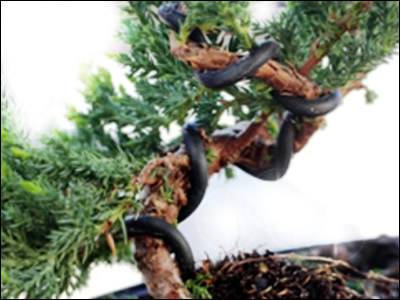This can usually be combined with double wiring, but when starting with a totally untrained tree you may wish to put some shape into the trunk, leave it to set and then wire the branches at a later date.
One of the most unique characteristics on a bonsai tree is its movement. This refers to the bends, curves, and twists present in the bonsai trees’ trunk. When working with your own tree, sometimes the easiest way to achieve movement is to create it on your own using wire.
Select a length of wire about ⅓ the thickness of the trunk and length at least 1½ times the length of the trunk being wired (never skimp on length - there is no way you can add more on if you get it wrong).
If you are wiring the entire bonsai, it is best to begin with the trunk and then move on to the largest branch and then to the next largest branch and so on.


Wired tree showing positioning of wire
Wire first with thickest wire (red) inserting into pot at base and wiring up the trunk.
Second wire (green) runs parallel to red but never crossing it, go above first branch and the continue tt end of it, you are planning to bend branch downwards so by placing wire above branch at joint you are supporting it.
Third wire (blue) goes above the green and again goes in beneath second branch as you also plan to bend it down, if you were bending it upwards you would place the wire in a supporting position above.
It is important that you wire in the direction of yourself. It is easier and safer, because you will be able to avoid wiring over any buds, leaves or twigs that may be hidden by your arms or hands; and at a pragmatic level, you will be able to cut off the excess wire as you reach the very end of the branch.
Place the wire deep in to the pot below soil level and hold very firmly for the first bend. Aim for an angle of 45° at each bend. When the wire is in place, hold the trunk firmly with pliers and bend very gently to the required position. Bend in gentle stages to avoid stressing the tree or even breaking the trunk. Once securely in place leave for a few days to enable the tree to recover before proceeding to wire the branches.
Wire should be applied to the trunk or branch at an angle of 45⁰ to reduce the likelihood of the branch snapping. You must have enough wire that you are bending the wire and thus bending the branch. If one piece of wire is used on two branches, it has a firmer anchoring effect.
